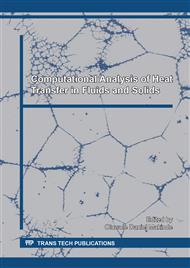[1]
W. Aung, G. Worku, Developing flow and flow reversal in a vertical channel with asymmetric wall temperatures, Journal of Heat Transfer 108 (2) (1986) 299-304.
DOI: 10.1115/1.3246919
Google Scholar
[2]
O. Aydin, M. Avci, Viscous-dissipation effects on the heat transfer in a Poiseuille flow, Applied Energy 83 (5) (2006) 495-512.
DOI: 10.1016/j.apenergy.2005.03.003
Google Scholar
[3]
A.N. Smith, H. Nochetto, Laminar thermally developing flow in rectangular channels and parallel plates: uniform heat flux, Heat and Mass Transfer 50 (11) (2014) 1627-1637.
DOI: 10.1007/s00231-014-1363-8
Google Scholar
[4]
O. Aydin, Effects of viscous dissipation on the heat transfer in a forced pipe flow. Part 2: Thermally developing flow, Energy Conversion and Management 46 (18-19) (2005) 3091-3102.
DOI: 10.1016/j.enconman.2005.03.011
Google Scholar
[5]
A.A. Ranjbar-Kani, K. Hooman, Viscous dissipation effects on thermally developing forced convection in a porous medium: circular duct with isothermal wall, International Communications in Heat and Mass Transfer 31 (6) (2004) 897-907.
DOI: 10.1016/s0735-1933(04)00076-4
Google Scholar
[6]
J.E.R. Coney, M.A.I. El-Shaarawi, Finite difference analysis for laminar flow heat transfer in concentric annuli with simultaneously developing hydrodynamic and thermal boundary layers, International journal for numerical methods in engineering 9 (1) (1975).
DOI: 10.1002/nme.1620090103
Google Scholar
[7]
M.A.I. El-Shaarawi, A. Sarhan, Combined forced-free laminar convection in the entry region of a vertical annulus with a rotating inner cylinder, International Journal of Heat and Mass transfer 25 (2) (1982) 175-186.
DOI: 10.1016/0017-9310(82)90003-5
Google Scholar
[8]
M. Al-Arabi, M.A.I. El-Shaarawi, M. Khamis, Natural convection in uniformly heated vertical annuli, International Journal of Heat and Mass Transfer 30 (7) (1987) 1381-1389.
DOI: 10.1016/0017-9310(87)90170-0
Google Scholar
[9]
H. Fayez, Al-Sadah, Finite difference analysis for heat transfer in a vertical annulus, Engineering Analysis with Boundary Elements 8 (6) (1991) 273-277.
DOI: 10.1016/0955-7997(91)90039-v
Google Scholar
[10]
M.A.I. El-Shaarawi, M.K. Alkam, Transient forced convection in the entrance region of concentric annuli, International Journal of Heat and Mass Transfer 35 (12) (1992) 3335-3344.
DOI: 10.1016/0017-9310(92)90220-m
Google Scholar
[11]
C. Nouar, M. Ouldrouis, A. Salem, J. Legrand, Developing laminar flow in the entrance region of annuli-review and extension of standard resolution methods for the hydrodynamic problem, International Journal of Engineering Science 33 (10) (1995).
DOI: 10.1016/0020-7225(95)00016-q
Google Scholar
[12]
M.M.J. Kumar, V.V. Satyamurty, Limiting Nusselt numbers for laminar forced convection in asymmetrically heated annuli with viscous dissipation, International Communications in Heat and Mass Transfer 38 (7) (2011) 923-927.
DOI: 10.1016/j.icheatmasstransfer.2011.04.018
Google Scholar
[13]
M.M.J. Kumar, V.V. Satyamurty, Effect of entry temperature on forced convection heat transfer with viscous dissipation in thermally developing region of concentric annuli, Journal of Heat Transfer 137 (12) (2015) 1 - 8.
DOI: 10.1115/1.4030908
Google Scholar
[14]
A. K. Tiwari, A. K. Singh, B.S. Bhadauria, Oscillatory natural convective flow in an infinite vertical annular duct filled with a porous material, International Journal of Energy & Technology 2 (7) (2010) 1-8.
Google Scholar
[15]
M. Sankar, Numerical study of double diffusive convection in partially heated vertical open ended cylindrical annulus, Advances in Applied Mathematics and Mechanics 2 (6) (2010) 763-783.
DOI: 10.4208/aamm.09-m0997
Google Scholar
[16]
M.M.S. El-Din, Developing laminar convection in a vertical double-passage channel, Heat and Mass Transfer 38 (1-2) (2001) 93-96.
DOI: 10.1007/s002310100203
Google Scholar
[17]
O. D. Makinde, Thermal stability of a reactive viscous flow through a porous-saturated pipe, International Journal of Numerical Methods for Heat & Fluid Flow,17 (8) (2007) 836-844.
DOI: 10.1108/09615530710825800
Google Scholar
[18]
O. D. Makinde,Thermal stability of a reactive viscous flow through a porous-saturated channel with convective boundary conditions, Applied Thermal Engineering, 29 (2009) 1773-1777.
DOI: 10.1016/j.applthermaleng.2008.08.012
Google Scholar
[19]
T. Chinyoka, O. D. Makinde,Computational dynamics of unsteady flow of a variable viscosity reactive fluid in a porous pipe, Mechanics Research Communications 37 (2010) 347–353.
DOI: 10.1016/j.mechrescom.2010.02.007
Google Scholar
[20]
O. D. Makinde, Thermal analysis of a reactive generalized Couette flow of power law fluids between concentric cylindrical pipes, European Physical Journal Plus, 129 (270) (2014) 1-9.
DOI: 10.1140/epjp/i2014-14270-4
Google Scholar


